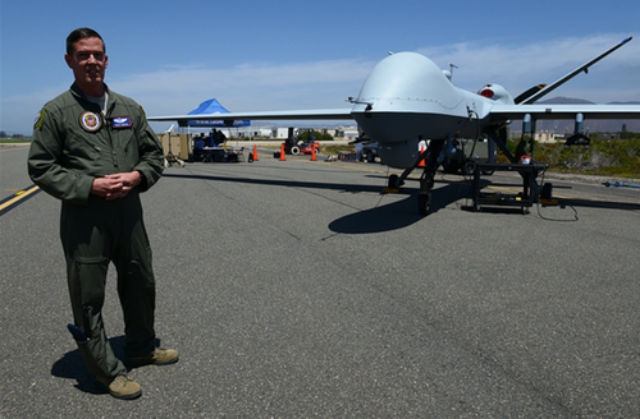Last week the joint U.S. military services held their invitation only “Black Dart” exercises aimed at demonstrating and testing the latest countermeasure technologies for defence against unmanned aerial vehicles flown by the enemy.
The exercises ran from July 26th through August 7th at the Naval Air Station (Point Mugu, California).
Black Dart is an annual U.S. Services joint exercise where vendors demonstrate their latest counter-measures to enemy drones, ranging from jamming their signal source to taking over direct control of them to shooting them down with high-powered lasers to ground-to-air missiles to sending up our own drones designed to conduct air-to-air destruction.

Air Force Maj. Scott Gregg, a Black Dart project officer, speaks to the media in front of a MQ-9 unmanned aircraft system, at Naval Base Ventura County and Sea Range, Point Mugu, Calif.
Black Dart has been conducting these exercises since 2010, but has drawn increased participation from the Department of Homeland Security since a number of incidents happened lately.
There has been a recreational drone crashed into a tree on the White House lawn undetected; more than a dozen drones sightings have been made over French nuclear reactors; a drone landed on the Japanese Prime Minister, Shinzo Abe’s residence.
All of them happened since Black Dart 2014 — not to mention the Northeastern University student Rezwan Ferdaus who was sentenced to 17 years in prison for plotting to attack U.S. targets with C-4 plastic explosives strapped to recreational drones in 2012.
One of the most active participants at Black Dart 2014 was SRC Inc. (North Syracuse, NY) a not-for-profit company formerly affiliated with Syracuse University.
SRC writes software tying together their AN/TPQ-50 counter-fire radar with the CREW Duke counter-improvised explosive device (IED) system and a very small armed drone called Switchblade, built by Aerovironment.
“SRC has been developing radars and working in electronic warfare for decades. We have existing, proven technologies that can be applied to the unmanned aircraft system (also known as drone) surveillance and disruption needs of our customers,” Dave Bessey, SRC’s Business Development Director and Counter-UAS program lead told EE Times.
“We originally tested our solutions a few years ago at Black Dart, and have been making improvements each year. Today, we are a leading provider of counter-UAS technologies to the U.S. Army.”
SRC showed its SR Hawk surveillance radar at Black Dart this year. It provides continuous 360-degree surveillance of the ground, harbors, and airspace, detecting personnel, land vehicles, marine vessels, avian targets, and low-flying aircraft like UAVs / drones.
The SR Hawk is used primarily for ground surveillance, air surveillance, border and perimeter surveillance, counter-UAV mission support, port and harbor surveillance, wind-farm bird strike avoidance, avian surveillance, and artillery spotting, but may find Homeland Security applications soon too.
Last month, the U.S. Department of Homeland Security sent a letter to police agencies nationwide warning the possibility of drones being used as weapons of attack, presenting a challenge to detect, track and identify the threat-level of commercially available UAV — for both terrorist and criminal activities.
Many potential solutions were presented at Black Dart using radar, electronic jamming and control signals to detect, track, identify, destroy, disrupt or take-over control of hostile UAVs.
“We take a layered approach to UAVs, first using radar to tell that something’s up there, then using other sensors and electronic signals like jamming to differentiate them from birds, then deciding if they are hostile, and if they are, finally deciding whether to take out them out, or their ground controllers, or both by choosing from a broad set of countermeasures,” Bessey told us.
“And I would just add to that, collateral damage becomes a very big issue,” Tom Wilson, Vice President of Product Accounts told us. “There are lots of ways to bring a drone down, but where you’re bringing it down becomes crucial especially in populated areas. The two big open areas are distinguishing drones from birds, once you decide its a drone then the second big area is deciding if its a threat or not, and third are what you do about it in a populated area — you can’t just shoot it down and if you use some other method how do you know you’re not going hurt some body when it crashes and end up in a lawsuit?”
On the battlefield, on the other hand, many of these complications go away, if you shoot down a bird or the UAV goes down in enemy territory, there’s usually no problem.
But in civilian areas its another story — one that has not yet been solved. “We’re really in the infancy of this, all the different organizations that handle security and force protection kind of issues are trying to work through what’s the right set of sensors, what’s the right kind of countermeasures, who is going to take it, what authorities do they need — all those sorts of things need to be worked through,” Bessey said.
The live-fire joint counter-UAV activities at Black Dart were kept far from civilians. Most of those attending were personnel from the four service branches, observers from allied nations and industry personnel — of the Joint Integrated Air and Missile Defense Organization (JIAMDO).
The biggest challenge, according to JIAMDO, is detecting and identifying hostile drones since they are so small — even smaller than some birds. There is also concern over sea-faring drones that could attack U.S. ships much like a torpedo, but at a fraction of their size. More than 70 countries today are using UAVs for government or military applications, according to JIAMDO, and even traditional model aircraft must be considered potential threats.
Photo: Lisa Ferdinando – Department of Defense
Source: EE Times
